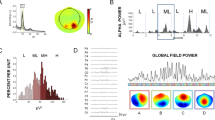Abstract
We recorded scalp electrical activity before and after full neuro-muscular paralysis in 5 volunteers and determined differences due to elimination of muscular activity on several standard applications of EEG. Due to paralysis, there were reductions in ‘noisiness’ of the standard scalp recordings which were maximal over the peripheral scalp, not explained by abolition of movement artefact, and best accounted for by sustained EMG activity in resting individuals. There was a corresponding reduction in spectral power in the gamma range. In central leads, the extent of gamma frequency coherence during a non-time-locked mental task (1 s epochs) was reduced by paralysis, likely due to a reduction in gamma-frequency coherence in widely arising EMG signals. In a time-locked mental task (auditory oddball), evoked responses were qualitatively unaffected by paralysis but 3 of 4 induced gamma responses were obscured by EMG.



Similar content being viewed by others
References
Barry RJ, Kirkaikul S, Hodder D (2000) EEG alpha activity and the ERP to target stimuli in an auditory oddball paradigm. Int J Psychophysiol 39:39–50
Fitzgibbon SP, Pope KJ, Mackenzie L, Clark CR, Willoughby JO (2004) Cognitive tasks augment gamma EEG power. Clin Neurophysiol 115:1802–1809
Tallon-Baudry C, Bertrand O, Peronnet F, Pernier J (1998) Induced gamma-band activity during the delay of a visual short-term memory task in humans. J Neurosci 18:4244–4254
Whitham EM, Pope KJ, Fitzgibbon SP, Lewis T, Clark CR, Loveless S, Broberg M, Wallace A, DeLosAngeles D, Lillie P, Hardy A, Fronsko R, Pulbrook A, Willoughby JO (2007) Scalp electrical recording during paralysis: quantitative evidence that EEG frequencies above 20 Hz are contaminated by EMG. Clin Neurophysiol 118:1877–1888
Whitham EM, Lewis T, Pope KJ, Fitzgibbon SP, Clark CR, Loveless S, DeLosAngeles D, Wallace AK, Broberg M, Willoughby JO (2008) Thinking activates EMG in scalp electrical recordings. Clin Neurophysiol 119:1166–1175
Willoughby JO, Fitzgibbon SP, Pope KJ, Mackenzie L, Davey M, Wilcox RA, Clark CR (2003a) Mental tasks induce gamma EEG with reduced responsiveness in primary generalized epilepsies. Epilepsia 44:1406–1412
Willoughby JO, Fitzgibbon SP, Pope KJ, Mackenzie L, Medvedev AV, Clark CR, Davey MP, Wilcox RA (2003b) Persistent abnormality detected in the non-ictal electroencephalogram in primary generalised epilepsy. J Neurol Neurosurg Psychiatry 74:51–55
Yuval-Greenberg S, Tomer O, Keren AS, Nelken I, Deouell LY (2008) Transient induced gamma-band response in EEG as a manifestation of miniature saccades. Neuron 58:429–441
Acknowledgements
The EEG Research Unit was funded by an equipment grant from The Wellcome Trust, London, UK. Project support has been provided by the National Health and Medical Research Council and Flinders Medical Centre Foundation. Dr Whitham was supported by a Pfizer Neuroscience Research Fellowship and an Epilepsy Society of Australia Fellowship from UCB Pharma. We also thank our colleagues Mr Dylan DeLosAngeles (Flinders University), Dr Bry Wyman (University of Wisconsin), Dr Arduino Mangoni (Flinders University) and Dr Rob Wilcox (Flinders Medical Centre), for their participation as subjects in the paralysis experiments, as well as Dr Peter Lillie and Dr Andrew Hardy (Flinders Medical Centre) for anaesthetic expertise.
Author information
Authors and Affiliations
Corresponding author
Additional information
This article is one of five on the “Special Topic: Discussing Gamma” in issue 22(1) of Brain Topography.
Rights and permissions
About this article
Cite this article
Pope, K.J., Fitzgibbon, S.P., Lewis, T.W. et al. Relation of Gamma Oscillations in Scalp Recordings to Muscular Activity. Brain Topogr 22, 13–17 (2009). https://doi.org/10.1007/s10548-009-0081-x
Received:
Accepted:
Published:
Issue Date:
DOI: https://doi.org/10.1007/s10548-009-0081-x



